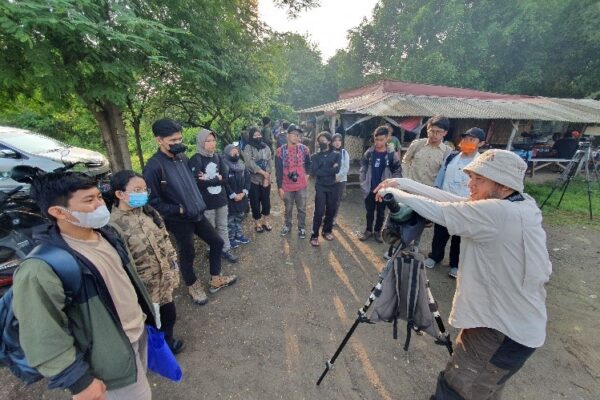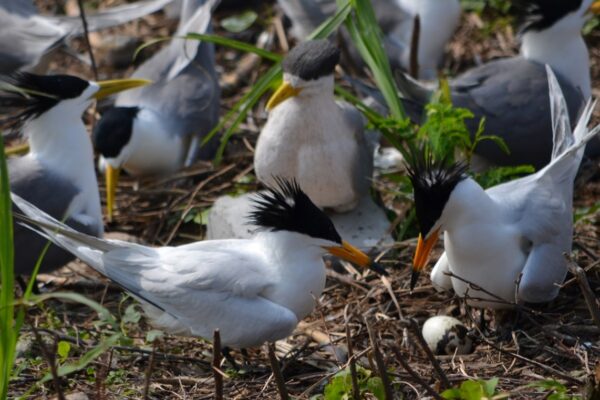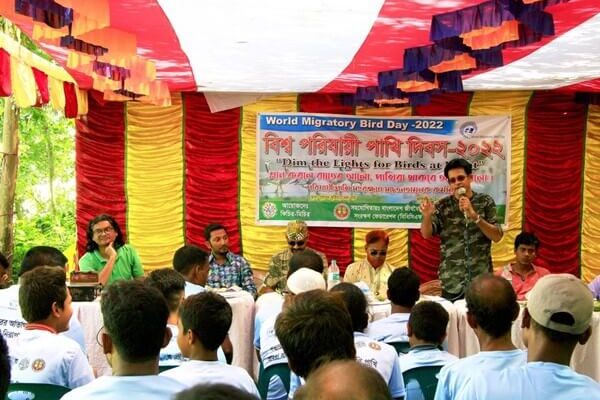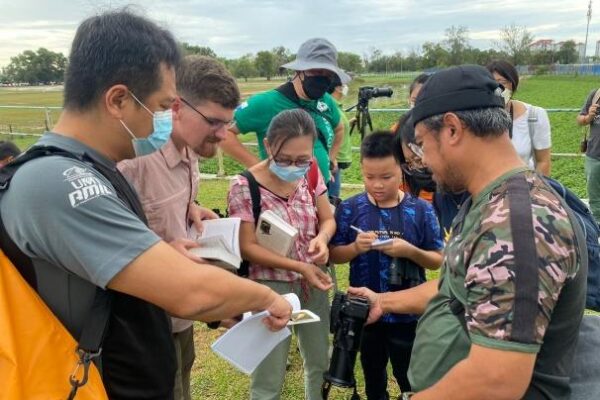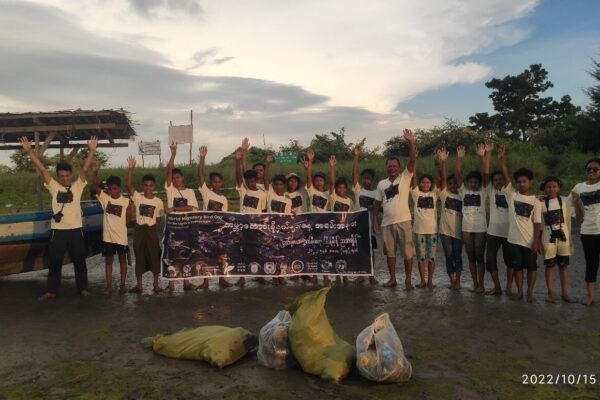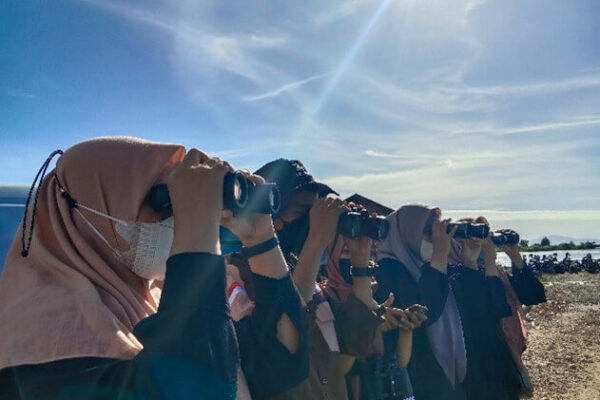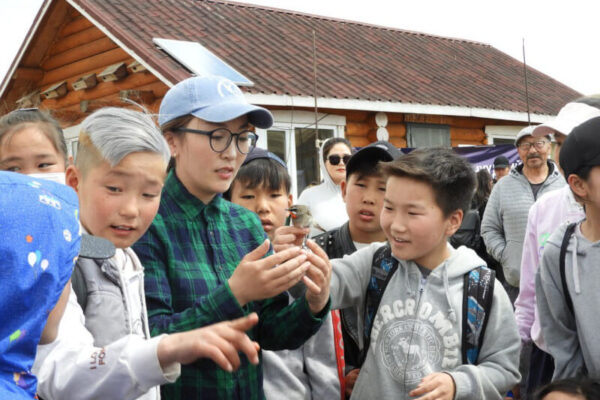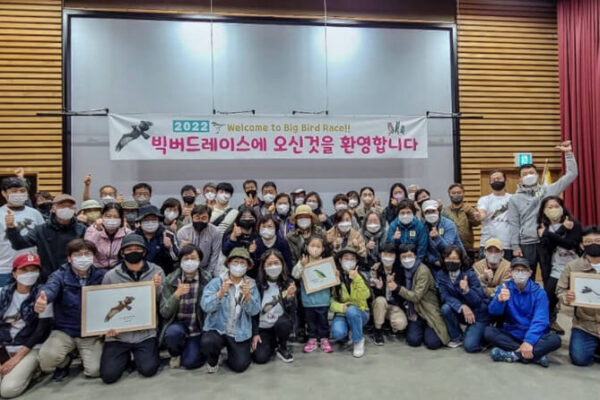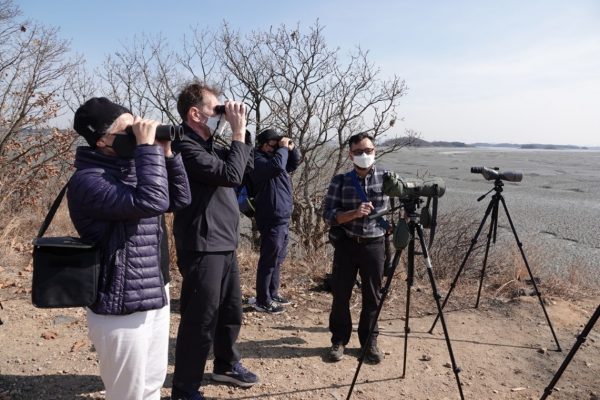-
Skilled Stakeholder Meets Technology: The Next Step of Migratory Waterbirds Conservation in Indonesia
EAAFP Small Grant Fund Project by Ragil Rihadini Yayasan Ekologi Satwa Alam Liar Indonesia (EKSAI Foundation) Indonesia, is one of the important wintering habitats for migratory waterbirds. With a total of 19.181 km shoreline (KKP, 2019), the information about migratory waterbirds in Indonesia is still little. Most records and information cantered in Java and Sumatra Island, this caused threats on the unknown potential sites (fig.01). Fig.01. Shorebirds Data (in red) from 2016-2022; source: burungnesia app. Many migratory waterbirds' important sites in Indonesia are not protected yet, some other are predicted as important sites but it needs more data and information to confirm that. Unfortunately, some of those areas do not have any birdwatchers who skilled in shorebirds identification. Meanwhile, threats such as hunting, habitat change, and other human disturbance frequently recorded in Indonesia; as the local people rarely understand the importance of conserving the waterbirds. As from our survey before proposing this project to the EAAFP, more than 60% of local birdwatchers are not familiar with waterbirds, and more than 70% are not familiar with migration and shorebirds. This makes us hard to access information about migratory shorebirds in Indonesia, and several times during our survey on new sites, we will find people hunting for waterbirds, simply because they did not know what is that, and how important it is to conserve the birds. The need for skilled birdwatchers as conservation agents: citizen scientists, bird researchers, college students, and government agencies to do regular and systematic surveys on the nearest potential habitat of migratory waterbirds. Fig.02. Field Training of Local Stakeholders in Indonesia Need of coordinated monitoring; cantered data (waterbirds database) that will help the scientists and management coordinator to determine the suitable action for shorebird conservation base on that data and information. With no coordinated monitoring and hunting assessment for migratory waterbird conservation, it will be hard to control threats and protect the birds (Eduardo et al, 2020). Fig.03 (a) the illustration of burungnesia.app (b) the data of Nordmann Greenshank in Indonesia from burungnesia app With support from the East Asia Australasia Flyway Partnership (EAAFP), we were able to combine conservation action and technology through a conservation training activity in Indonesia last November – December, 2022. The small grant from the EAAFP makes us able to reach and develop the shorebirds conservation skills and knowledge of at least 30 of local stakeholders from all around Indonesia (from Papua to Sumatra); covers the government agencies, national parks’ agents, college students, birdwatchers, and local NGOs representative. They got several materials about migratory waterbird conservation during the training: creating a community and research-based conservation program; shorebirds habitat management; shorebirds identification, etc. They also got access to discussing their on-field problems with experts during and after the training. In the process to creating a coordinated monitoring and shorebirds database in Indonesia, we collaborate with our partners in Burungnesia.app; an android application for submitting birds checklists. All the trained participants are mandatory to install and register in Burungnesia.app; they also train on how to submit and using this app. By combining the skilled stakeholders and this technology we hope the data, information, and study about migratory shorebirds in Indonesia will increase, also the conservation action and protection of shorebirds in Indonesia will become a serious attention. The project was funded through the 2022 EAAFP WG/TF Small Grant Fund. View the report, Click here.
Continue reading -
Special achievement award to the Chinese Crested Tern team
Nesting Chinese Crested Tern on Tiedun Dao of Jiushan Islands next to decoys for social attraction © Simba Chan At the Pacific Seabird Group banquet held at the Birch Aquarium, Scripps Institution of Oceanography, La Jolla, California, 17 February 2023, a Special Achievement Award was presented to three persons who contributed to the recovery of the critically endangered Chinese Crested Tern: Dr Shuihua Chen of the Zhejiang Museum, Prof. Hsiao-wei Yuan of the National University of Taiwan, and Simba Chan of the Japan Bird Research Association/Wild Bird Society of Japan. This is the third time the Pacific Seabird Group presented a Special Achievement Award to Asian seabird researchers. Previous awardees were Prof Hiroshi Hasegawa of Toho University (2001) and Prof Yutaka Watanuki of Hokkaido University (2009). Special Achievement Award presented to Mr. Simba Chan (left), Prof. Hsiao-wei Yuan (middle) and Dr Shuihua Chen (right) at the Pacific Seabird Group meeting © Simba Chan The works of the three awardees were linked to the compilation of the International Single Species Action Plan for the Conservation of the Chinese Crested Tern (Sterna bernsteini) under the Convention of Migratory Species (CMS). After the publication of “Threatened Birds of Asia: The BirdLife International Red Data Book” in 2001, BirdLife International and the CMS have chosen three species for follow-up conservation actions: Spoon-billed Sandpiper, Black-faced Spoonbill and Chinese Crested Tern. These action plans were launched at the 4th Meeting of Partners of EAAFP (MOP4) held in Incheon, Ro Korea, and the International Black-faced Spoonbill Workshop in Fukuoka, Japan, in early 2010 respectively. Simba Chan was the editor-in-chief of the Chinese Crested Tern Action Plan. When he started to work on the action plan in 2005 he contacted Shuihua Chen, who discovered the second breeding ground of Chinese Crested Tern at Jiushan Islands in Zhejiang Province in China in 2004, and Hsiao-wei Yuan who was a tern expert recommended by Dr Lucia Liu Severinghaus of Academia Sinica in Taiwan, who identified the Chinese Crested Tern from photos taken by wildlife documentarist Chieh-te Liang from Matsu in 2000. The trio met at Zhejiang Museum of Natural History in Hangzhou on May 2006 and that should be the start of the Chinese Crested Tern saga. Meeting on the Chinese Crested Tern Action Plan in Hangzhou on 22 May 2006. © Simba Chan In the 2000s the biggest threat known to Chinese Crested Terns was illegal egg collection. The BirdLife/Hong Kong Bird Watching Society China Programme worked with bird conservation organizations in Zhejiang and Fujian on promotion of local awareness in seabird conservation. For this purpose an international seabird symposium was convened in Xiangshan in July 2010. Prof Daniel Roby of Oregan State University was invited and he made a presentation on social attraction project of Caspian Tern in northwest USA. The talk initiated the interest of breeding site restoration and workshops on the feasibility of using social attraction at Jiushan Islands in Zhejiang Province of China were held in 2011, 2012 and 2013. The first attempt of social attraction in 2013 was a late success (no terns were attracted to the site until the playback system was fixed in mid-July, then terns started to breed despite it was very late in the season) and monitoring on the island in 2014 and 2015 confirmed the method worked. Since then, Jiushan became the main breeding site of the Chinese Crested Tern and 20 or more chicks fledged every year (expect 2016). The global population of Chinese Crested Tern in 2013 was less than 50 birds. In 2023 its number increased to around 200 birds. Chan, Chen, Yuan on Tiedun Dao for restoration of the Chinese Crested Tern colony at Jiusha Islan, Zhejiang, China on 17 July 2015. © Simba Chan This is not the end of the story, in late 2022, Simba Chan and Yat-tung Yu, Director of the Hong Kong Bird Watching Society, convened a virtual workshop for Korean and Chinese researchers on planning of restoration of breeding sites of Chinese Crested Terns in Korea and northern China (especially in the vicinity of Qingdao, where the last colony was recorded in 1937). Chan and Yu have also been working with colleagues from Indonesia and the USA on researching and protecting Chinese Crested Tern wintering sites in eastern Indonesia. We hope more people can support us and join the team. The success of the Chinese Crested Tern conservation was a result of team work, the three awardees are representing those who work hard in the field in mainland China, Taiwan and other countries. The secret of the success was a combination of good planning (the action plan and beyond), a good and dedicated team, and the spirit of international cooperation. Recently the EAAFP Black-faced Spoonbill Working Group worked with the IUCN Stork, Spoonbill, and Ibis Specialist Group on a paper (link) on the success of conservation of the once (prior to 2000) critically endangered Black-faced Spoonbill. The essence of success was the same as we listed above. And we believe this is also a lesson to learn for many other migratory species and species groups in the East Asian-Australasian Flyway. Read also: How Plastic Birds Are Bringing Crested Terns Back From the Brink (published on 2015, available at link)
Continue reading -
Celebration of World Migratory Bird Day 2022 in western Bangladesh
With the aim to contribute towards the conservation of migratory birds and their habitats by mitigating threats caused by the local community along a river-adjacent area of western Bangladesh,…
Continue reading -
Celebration of World Migratory Bird Day 2022 in Malaysia – The Wonders of Bird Migration Around the Globe
The International Centre from University Sultan Zainal Abidin (UniSZA), in collaboration with the Malaysian Nature Society (MNS), Terengganu Branch and the University of Tripoli, Libya, organized an outing in…
Continue reading -
World Migratory Bird Day in Nanthar Island Marine National Park, Rakhine State
Nature Conservation Society-Myanmar (NCS) in cooperation with Rakhine Biodiversity and Nature Conservation Association(RBANCA) and the Forest Department organized the second World Migratory Bird Day(WMBD) event for 2022 at the…
Continue reading -
World Migratory Bird Day 2022 in Indonesia with HIMPUS
The World Migratory Bird Day 2022 celebration this October was organized by HIMPUS (Poultry Lovers Association) Veterinary Medicine students at Syiah Kuala University, Banda Aceh, Indonesia, implementing various awareness…
Continue reading -
2022 World Migratory Bird Day Celebration in West, South and Eastern Mongolia
The celebration of World Migratory Bird Day (WMBD) 2022 in Mongolia by Wildlife Science and Conservation Center (WSCC) in West, South and Eastern Mongolia was a success. WSCC, Mongolia has been celebrated WMBD since 2010s by small grants or organization’s own funds every year with various public awareness activities following each year’s WMBD theme and slogan. Demo talk how to use opticals, Southern Mongolia ©️ Wildlife Science and Conservation Center - Mongolia The celebration was organized between 12 – 20 May in Western, Eastern and Southern Mongolia, supported by EAAFP WMBD small grant and cooperation with WWF Mongolia, Oyu Tolgoi LLC, and high schools of every soum (area of pastureland) in the vicinity. All three sites were very special places for migratory birds and thus, it is very important to involve local kids and teachers to explain the bird species around the home. Students bird watching, Western Mongolia ©️ Wildlife Science and Conservation Center - Mongolia Demonstration talk of how, why we ring birds, Western Mongolia ©️ Wildlife Science and Conservation Center - Mongolia Over 910 participants have been reached out through this event to share about bird research and migratory birds’ conservation, especially how to deal with light pollution to protect migratory birds and other animals. Many of the school students joined this kind of activities for the first time to learn about WMBD, and they would keep this memory of the event in their hearts. Releasing Siberian Rubythroat, Eastern Mongolia ©️ Wildlife Science and Conservation Center - Mongolia Two competitions, birdwatching competition and bird drawing competition, were very attractive to all kids, and they enjoyed learning about birds and bird migration through these two competitions. Most importantly, the two ringing stations also tremendously aided in the learning - on bird study and conservation - for all attendees and their knowledge have greatly strengthened for their future, proven by the fact that several students have been started volunteering as an assistant ringer position when they have free time afterschool. Children heading out for the bird ringing activity, Eastern Mongolia ©️ Wildlife Science and Conservation Center - Mongolia Drawing competition in progress at the Khurkh BRS, Eastern Mongolia ©️ Wildlife Science and Conservation Center - Mongolia Information leaflets were distributed among all participants in E and Western Mongolia. A total 12 winners of two competitions were rewarded with education materials such bird guidebook and wildlife conservation related books and painting materials. Presentations in Western Mongolia ©️ Wildlife Science and Conservation Center - Mongolia In the Western Mongolian activities were supported by WWF Mongolia, and they helped us with arranging education materials and rewards for the contest winners. Mongolian Bird Watching club members celebrated Global Big Day on 14 May as well, Team Mongolia observed 254 species in 24 hours, and was one of the biggest successes among the team members. They are very proud of their bird’s species diversity and were encouraged by our results which was 4th place in the Asia and 16th place in the world team rank. Many young members of the Team Mongolia were motivated for bird watching and delighted by our team efforts for Global Big Day. Students birdwatching, Southern Mongolia ©️ Wildlife Science and Conservation Center - Mongolia Team recording what they saw, Southern Mongolia ©️ Wildlife Science and Conservation Center - Mongolia Article prepared by Mongolia by Wildlife Science and Conservation Center (WSCC).
Continue reading -
Ganghwa Big Bird Race for 2022 World Migratory Bird Day
From 30 April to 1 May 2022, the <Ganghwa Big Bird Race> was organized by Moolsaeal, a local NGO, on Ganghwa Island, Republic of Korea. A total of 26 teams, 110 birdwatchers from across the country (14 competitive, 12 non-competitive) spent 24 hours searching for birds in Ganghwa Island. Unlike normal birding competitions, all birds observed must be photographed and uploaded to a monitoring App called 'Getbol keepers'. With the records listed on this monitoring App, the judges score and rank them. The competition, which began with a congratulatory greeting from EAAFP Chief Executive Mr. Doug Watkins, followed by the lectures introducing Ganghwa birding places and instructions of the race. The BBR then kick-started in the heated atmosphere. Group Photo of Participants and Organization Committee ©️ 2022 Ganghwa Big Bird Race Organization Committee Families and EAAFP secretariat staff, who participated in the non-competition section, then attended a lecture by the organizer to learn about common bird species. Then they visited rice paddies and mudflats with professional birding guides for bird watching. At the end of the first day, there was a music performance to celebrate the event, followed by a sharing section in which all the teams were introduced and expressed their feeling for joining the Ganghwa BBR. Families participating in the non-competitive Birdwatching section ©️ 2022 Ganghwa Big Bird Race Organization Committee EAAFP Secretariat Staff at Ganghwa BBR ©️ 2022 Ganghwa Big Bird Race Organization Committee During the BBR, teams observed a total of 581 photo records and 102 bird species for two days. The first-place team scored 75 points (69 records + 6 additional points for protected species), the second-place team scored 56 points (51 records + 5 additional points for protected species), and the third-place team scored 55 points (51 records + 4 additional points for protected species). Participants for the competitive section ©️ 2022 Ganghwa Big Bird Race Organization Committee Families participating in the non-competitive section ©️ 2022 Ganghwa Big Bird Race Organization Committee Some sharing from the participants:Mr. Rahul Teku Vaswani and his family, from India, saw a black-faced spoonbill biting a giant frog and said, “It’s so amazing. The colors and patterns made by nature are really beautiful.” Another participant said, "There were not many birds this year. Continuous monitoring is needed, whether it is due to climate change or other environmental factors. We expect more people to participate next year.” For more on Ganghwa BBR (in Korean) https://ghbbr.modoo.at/?link=cgfdi6ow Article prepared by Moolsaeal.
Continue reading -
Envisioning Roadmap of the Gochang Tidal Flat World Heritage Site management
To further develop the roadmap for advancing management of Gochang Tidal Flat after its designation as a World Heritage Site in Ro Korea, a 2-day technical workshop for…
Continue reading -
Red-crowned Crane Birdwatching Event at Ganghwa Island, Ro Korea with GCF and Irang
On 27 February, the EAAFP Secretariat and 5 staff of Green Climate Fund (GCF) participated in the Red-crowned Crane Birdwatching event organized by Eco Edu hub Irang which is…
Continue reading
- 1
- 2

